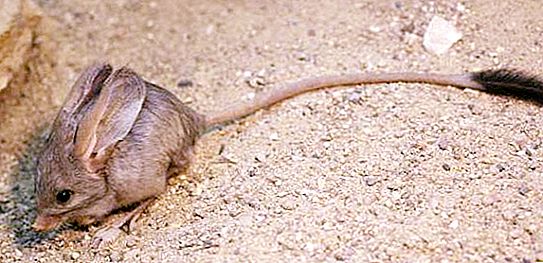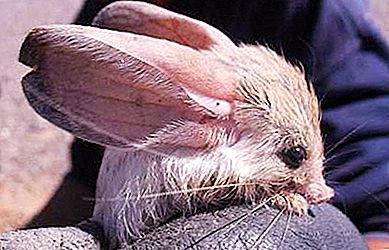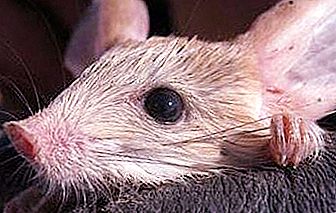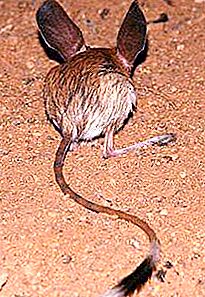A small animal with huge ears, long hind limbs and a thin long-long tail with a black and white tassel - this is how a long-eared jerboa looks. The animal looks ridiculous in the photographs, and at first glance it is very difficult to understand why it needs such excesses.

Long-eared jerboa: description
It is worth saying that for the first time this mysterious rodent was videotaped in 2007 by members of the London expedition led by Dr. Bailey (London Zoological Society), although the species was studied in detail in the twentieth century. One of the goals of the expedition to the Gobi Desert was to study the long-eared jerboa under natural conditions.

The length of his body is a maximum of 9 cm, tail - up to 17 cm, ears - up to 5 cm, foot length - up to 4.5 cm.
The head of an unusual form for the other jerboas is wedge-shaped, elongated, with a small stigma (like a pig), Eyes wide apart, small.
The coat is soft, thick, high.
Color: light red to buffy on the top, bottom can be light to white.
The tail has the same color along the entire length, the tassel at the end is white and black, not flat like the rest of jerboas, but round.
The front legs are small, their inner finger has a long curved claw.
The hind limbs are long and very narrow. Two lateral fingers are short, in the middle are three long. All fingers have developed hard pads.
Way of movement: exclusively on the hind legs (like a kangaroo). Jumping up to three meters.
Habitat
The rodent was first described in 1890 on samples from China. Mongolian representatives of this species were found much later, first in 1954, and already by the participants of the joint expeditions of the USSR and Mongolia in the seventies of the last century, the Mongolian long-eared jerboa was studied in more detail.

Where does this rodent live? His life passes in the Gobi desert, consisting of a chain of small deserts located in the territories of Mongolia and China.
The climate of this desert is sharply continental - in winter to minus 55, in summer to plus 58. The temperature difference, therefore, is 113 degrees (for comparison: at the cold pole in Oymyakon it is less - 112 degrees).
Each of the deserts differs in the composition of the soil (from rocky plateaus to sand dunes), the presence of vegetation (from the poor - rare bushes of saxaul, to meadow steppes in places where groundwater reaches the surface).
Long-eared jerboa in the Gobi desert was seen in sandy areas with low vegetation (saxaul).
According to the latest estimates of scientists who regularly conduct observations, it was found that their numbers are extremely low - only 0.5 individuals per hectare of habitat.
Long-eared jerboa: what it eats
Unlike its main relatives, whose plants became food, the animal eats insects. He does not drink, getting liquid with an insect.
Its long ears allow you to hear any vibration in the air at a distance of up to five meters. Vibrissae (long whiskers) smell an insect in flight and under a layer of soil. Long legs provide an exceptional opportunity to quickly overtake an insect and catch it in a high (up to three meters) jump.
Proportions
When the long-eared jerboa very quickly runs (jumps), its large ears are firmly pressed to the body and reach the ends of the sacrum.
The mustache (vibrissa) growing on the muzzle is also long, and their tips (if bent) reach the base of the tail.
The front legs are small, their length is only one third of the hind legs.
The tail is almost two to two and a half times larger than the animal itself.
Lifestyle
Long-eared jerboa leads a nocturnal lifestyle, this is due to the rather high daytime temperatures in the desert.
Due to the sharp drop in temperature in winter, these little creatures cannot heat themselves, for this they would need to spend a lot of energy and eat very well. They sleep in winter, having previously accumulated enough fat, including along the entire length of the tail.
A long-eared jerboa digs a so-called winter cave, very deep - up to two meters (so as not to freeze), with a long tunnel and a camera in which he sleeps.
In summer, the rodent digs out three types of holes: life-saving, daytime and permanent. Depth of rescue - only 20 centimeters, daily (for sleep) - 50 centimeters. There is a special approach to permanent holes: the central course is inclined, leads to the chamber with reserves and the main one, the spare ones simply end in a dead end. The jerboa is lining the main chamber, located in the far part of the hole, with suitable remains of vegetation. In case of danger, the animal moves very quickly from the main chamber to the emergency passage, and the entrance to it immediately clogs with a sand cork.
If the animal does not catch prey, he digs his mink.
Features that help you survive
The ears of a long-eared jerboa are not so much long as they are huge (relative to the surface of the body) in area. What for? In the desert, in the summer the air can warm up to 50 degrees, and an unusually large network of blood vessels in the ears helps the rodent to cool (in fact, just like an elephant).

It is interesting that the ears of a waking animal are always in tension. They fold back when it moves fast (for example, running away from danger). And during the rest, the ears are soft, their blood supply is reduced.
On the hind legs of a long-eared jerboa, special bristly hair grows, which help it to stay on loose sandy soils. And solid pads - make it possible to deftly move on a rocky plateau.
The long tail is involved in pushing away from the soil during the first jump, in subsequent jumps it is straightened and serves as a kind of steering wheel when changing the direction of movement.
Short front limbs are needed for digging holes, digging up insect larvae, and a wedge-shaped (piggy) nose helps in these activities. With its front paws, the rodent keeps prey, makes gags for burrows.
Long-Eared Rodent and the Environment
Jerboa corrects the number of insects in its range. Although the little knowledge of animals does not allow us to say the opposite with confidence.
According to the observations of English zoologists, long-eared jerboa can tolerate tularemia and plague.
Helicobacter pylori microorganisms were found in rodent feces, and this is a direct threat to human health.
Domestication of the long-eared is not practiced, due to the paucity and difficulties in obtaining the animals themselves.
According to Soviet researchers, captive rodents begin to bite.
Reproduction
After hibernation, females are ready for mating. One individual can carry and feed from two to six babies. Due to the small number and difficulty of tracking, it has not yet been established how many times in a lifetime a long-eared rodent produces offspring. Some scientists draw a parallel with similar subspecies, arguing that the aforementioned rodent lives from two to three years and brings offspring several times. According to others, the rodent breeds only once in a lifetime, and lives up to six years.
Females can theoretically fully feed eight babies, having the same number of nipples arranged in two rows.






